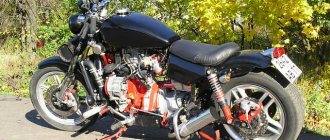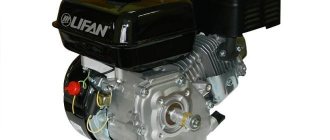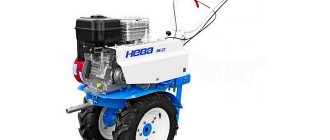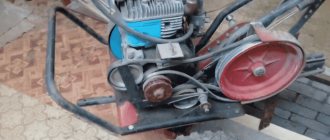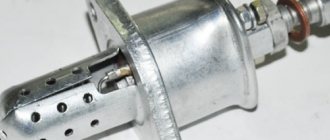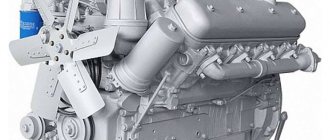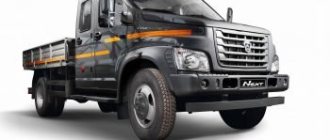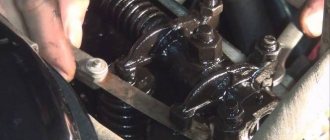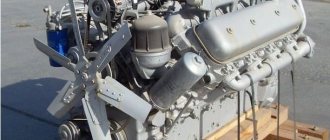FUEL PIPES FOR ENGINES YaMZ-236N, YaMZ-236NE2, YaMZ-236NE, YaMZ-236BE2, YaMZ-236BE, YaMZ-236B
To supply fuel to the pump and injectors, as well as to remove excess fuel, the engine has a system
low and high pressure fuel lines.
Low pressure fuel lines are connected with hollow bolts or union nuts through
tips attached to the ends of the fuel lines.
The contact surfaces are sealed with copper washers 1.5 mm thick.
The high pressure fuel lines are the same length for all engine cylinders. The ends of the fuel lines are set in the shape of a cone and pressed with union nuts to the fittings of the high pressure fuel pump and injectors. To avoid damage to fuel lines due to vibration, they must be secured using special brackets. The operating order of the sections is different for different fuel injection pump models (see section “Technical characteristics”), therefore the diagrams are different
connections of high-pressure fuel lines between fuel injection pump sections and engine cylinder injectors.
Rice. 39. Connection diagram of high-pressure fuel lines between fuel injection pump sections and engine cylinder injectors: a) fuel injection pump model 133 (1-2-3-5-4-6) b) fuel injection pump models 604, 607 (1-4-2-5- 3-6);
The durable fuel injection pump YaMZ 236 is located in the camber of the cylinder block of the power unit. At the end of the rail there is a bushing with a screw.
The plunger pairs are mounted in the housing of the YaMZ 236 fuel injection pump installation.
There are also fittings and discharge valves inside. The parts are connected to the pipeline.
The fuel injection pump type of the YaMZ 236 engine is multi-section. The pump is equipped with a gear drive.
Principle of operation
Oil splashes and lubricates the rubbing couples on the YaMZ 236 injection pump. Under pressure, the liquid is directed to several elements of the system:
- Bearings;
- Pushers;
- Rocker arms;
- Rod support;
- Drive;
- Air brake bearings.
Gears, cylinders and cams do not require separate lubrication. The rubbing mechanisms are processed by oil leaked from the bearing holes.
The YaMZ 236 injection pump device has autonomous lubrication. The liquid collects in a tray from the pipe. The volume of lubricant is regulated by a wire feeler gauge with level marks. The double filtration system provides fine and coarse oil purification.
see also
Comments 43
Try ignition a little earlier and add fuel.
Here truck drivers advise where and what screws to turn
I am posting a video about leaky gaskets under the heads...
it reacts like this. when there is not enough fuel, the thrust of the gas is sharp until the end of the smoke, either there is no smoke, or the gray one turned the bolt half a turn, the gas was blown by a ball of black smoke, and then the normal exhaust means it reacted, and if not, it means that in the inside under the cover it is on 6 or 4 bolts, the thrust is turned out and the bolt it does not limit it, then you need to twist it and then use the bolt in the opposite direction.
from the rear on the turbine side.
I work at KrAZ myself.
In the third picture, unscrew bolt 19 completely, and then adjust the fuel supply. Open or close.
Don't think that I'm stupid! :) BOLT!) unscrew completely or 19? Should I adjust 10 or 19?
In short, I adjusted it myself like this: one bolt in front on the side of the coupling near the check valve. It regulates the stroke of the rack and is tightened during break-in (the so-called virgin), so it must be turned out completely. Now you look at the equipment from the back. There is a large bolt in the middle - it regulates idle, set it as it should. Then look below, at the bottom right there is a small bolt with a nut set to 10. This is a power limit. You unscrew it completely. If after that it starts smoking a lot black, it means there is a lot of fuel, open the lid and see two more bolts : larger and smaller. Don’t touch the larger one, the smaller one regulates the fuel supply. You need to turn it a quarter turn. clockwise - you decrease it, counterclockwise - you add it. Spun it, close the lid, work it, look for the smoke, if you don’t like it, turn it again and you won’t like it until you like it. When you suddenly add load or when moving under load, the engine should smoke slightly black, but not thickly and not completely without smoke. This is what a very good equipment technician taught me, who repaired it for me. I adjusted it, I answer you: the machine pulls at 5+ and the consumption is very low compared to other KrAZ trucks in our database. I carry a 60-ton trawl, believe me, all this is important. If I didn't pull well, I simply wouldn't be able to work. I also adjusted the ignition. This whole thing about 19 degrees is complete crap. No matter how many times I tried to set it according to the manual, well, it doesn’t work as it should. You adjust it several times by ear. It growls, smokes and works hard - early, it’s dull and quiet it works later. You find the golden mean at random and rejoice. Experience on the same machine is nine years, I think it’s enough to study.
Thank you! Informative! We usually do the ignition ourselves by eye. I understand about the pump. I’ll try it!
Don’t forget about non-injection pump malfunctions (see above)
Bolt 10 must be unscrewed completely, this is the rack travel limiter; by the way, it is tightened during conservation and break-in. Sometimes it tightens spontaneously; if you want to regulate the fuel supply, you open the back cover and the adjusting bolt is on the top left. To add, unscrew, decrease, tighten. Unscrew literally a quarter turn and try while driving. Otherwise, for non-injection pump reasons, there could be a banal clogging of the fuel filter(s), a clogged fuel intake strainer in the tank, a burst spring in the pump, ignition.
Features of High Pressure Fuel Pump
The YaMZ 236 injection pump device is installed on diesel engines. It has a V-shaped arrangement of plungers. Consists of six sections located at a distance of 36 mm from each other.
Injection pumps provide cyclic flow and injection pressure up to 1600 bar. The device is equipped with an all-mode regulator.
How does the YaMZ 236 injection pump installation work?
The plunger moves down. Fuel fills the inner cavity of the bushing. At this moment, the low pressure pump supplies fuel to the housing valve.
When the inlet port is opened, fuel is directed into the space above the plunger. The pressure in the system increases. Fuel is forced through the fuel line to the injector. The plunger compresses the fuel. As the pressure increases, fuel injection starts.
Adjusting the injection pump YaMZ 236
The fuel pump is checked on a special stand. Define:
- The moment of beginning;
- Magnitude;
- Uniformity of fuel supply.
Adjusting the YaMZ 236 injection pump serves to change the amount of fuel supplied to the system. The fuel portion is determined based on the engine load. Thanks to the adjustments, it is possible to maintain the crankshaft speed set by the driver.
Also provided with a mechanical regulator. The device is located at the end of the pump.
To adjust the start of fuel supply, install the pusher heel under the plunger. Measure the shaft rotation angles and compare them with the table data. An inaccuracy of no more than 1/3 degree is allowed.
The amount and uniformity of fuel supply to the injection pump of the YaMZ 236 engine is regulated using a set of nozzles. A pressure of 0.1 Pa is created at the pump inlet. The adjustment is performed according to the following scheme:
- First, check the shaft speed;
- Then turn the control lever all the way;
- Check the timing of the ejection of the racks.
To reduce the rotation speed of the YaMZ 236 injection pump, the adjusting bolt is loosened.
The inlet and outlet channels are clogged with plugs with O-ring seals. The fuel line is connected to the coupling side. Excess fuel is removed through the bypass valve.
The axial play of the YaMZ 236 fuel injection pump device is adjusted using a set of shims within a range of up to 0.07 mm.
How to add fuel to Yamz 238
That's the point. I work on a small locomotive with a YaMZ 238 engine. Without a turbine. We have many different ones. We recently received this one from conservation from another city to replace our broken one. We replaced both head gaskets because the system was airborne, the engine was boiling and the heater was not heating up due to the plugs. But it's not that. Not going! I mean, it doesn’t pull well. It starts up great. It doesn’t smoke. There’s the smell of unburnt diesel fuel, etc. No. My partner thinks that he eats a little more than usual. What's the question. While opening the engine, we realized that the wear was minimal, and the valves were adjusted. The air filter is not clogged. WHY doesn't it pull? ignition... ? Or should I still try to Crank up the pump? Who's familiar with this? how to do this and what bolts to turn there? I'M REALLY LOOKING FORWARD!
Parts and spare parts, maintenance, service and repair
GAZ cars
ZIL cars
KAMAZ vehicles
MAZ cars
KRAZ cars
YaMZ-6563 – a combination of high power and environmental friendliness
YaMZ-6563 can rightfully be considered the third generation of diesel engines of the Yaroslavl Motor Plant. The ancestor of the family is the legendary YaMZ-236, which has been regularly performing its functions for about half a century. The second generation - YaMZ-7601, YaMZ-236BE2, YaMZ-236NE2 is much younger and significantly different from its predecessor, meeting Euro 2 environmental standards. In 2007-2008, key positions were transferred to YaMZ-6563, which is more advanced technically and in terms of emissions of harmful substances fully compliant with Euro 3.
YaMZ-6563 device
The 6-cylinder diesel engine YaMZ-6563 with a power of 230 hp is equipped with turbocharging, liquid cooling and direct fuel injection. The cylinder arrangement is V-shaped. The cylinder displacement is 11.15 liters , and the specific fuel consumption (minimum) is 147 g/hp h . Manufacturers provide a guarantee for 100,000 km, with a service life before major repairs of 1,000,000 km (15,000 hours). The operating instructions emphasize the need to regularly visit the service center - the YaMZ-6563 diesel engine requires professional maintenance. Moreover, this work must be carried out in proper conditions.
| Number and arrangement of cylinders | V6 | |||
| Cylinder diameter, mm | 130 | |||
| Piston stroke, mm | 140 | |||
| Cylinder displacement, l | 11,15 | |||
| Compression ratio | 17,5 | |||
| Power, kW (hp) | 169 (230) | |||
| Rotation speed, rpm | 1900 | |||
| Maximum torque, Nm (kgfm) | 882 (90) | |||
| Frequency at maximum torque, rpm | 1100-1300 | |||
| Minimum specific fuel consumption, g/kW h (g/hp h) | 200 (147) | |||
| injection pump | 136.2-30 | |||
| Lifetime before major overhaul | 15,000 hours or 1,000,000 km | |||
| Warranty resource | 100,000 km | |||
| Model | YaMZ-6563.10 | YaMZ-6563.10-04 | YaMZ-6563.10-06 |
| Clutch | YaMZ-182-15 | ZF Sachs | YaMZ-182-15 |
| checkpoint | YaMZ-2361-06 | YaMZ-2361-88 | YaMZ-2361-87 |
| Dimensions, m | 1,91×1,045×1,097 | 1,86×1,045×1,08 | 1,91×1,045×1,08 |
| Weight, kg | 1310 | 1300 | 1300 |
| Applicability | MAZ vehicles with a 4×2 wheel arrangement, road trains based on them with a total weight of up to 32 tons; truck tractors MAZ-5433A2-320, MAZ-5433A2-322; dump trucks MAZ-5551A2-320, MAZ-5551A2-325, MAZ-5551A2-4327; chassis MAZ-5337A2-340, MAZ-5337A2-341, MAZ-5337A2-346, MAZ-5337A2-370, MAZ-5337A2-380; MAZ-5551A2-340, MAZ-5551A2-350 | LIAZ buses, JSC "Michurinsky Bus" | NEMAN buses (PRUP OZ "Neman") |
In order to comply with environmental standards, the YaMZ-6563 uses a specially developed version of the injection pump - “Compact-40”, model 136. Instead of mechanical control of the fuel pump, electronic control is used. The engine is supplied with an ESU-1 control unit, which, among other things, has a connector for diagnostic equipment. Thanks to this option, repairing YaMZ-6563 diesel engines requires less time.
ESU-1A includes a microprocessor ECU (M230.EZ) and a set of sensors that monitor the condition of the charge air, namely its pressure and temperature, there are sensors that measure the temperature of the fuel and coolant, pressure and oil temperature. To measure such an important parameter as the crankshaft speed, 2 sensors are used, one of which is a backup one.
The engine has an emergency shutdown valve , designed to protect the engine from various emergency situations that can lead to breakdowns and a reduction in service life. The emergency stop flap is controlled in the following ways:
- automatically,
- remotely,
- manually.
Automatic control is provided by an electronic unit. For remote control, you can use the button located in the car’s cabin on the dashboard. In addition, the damper itself is equipped with a button for manual control. It is located directly on the fuel injection pump housing.
To improve environmental performance, closed-type forced crankcase ventilation is used. The design features of this system make it possible to eliminate emissions of harmful substances into the atmosphere such as crankcase gases and oil mist. A modern filter finely purifies a much larger volume of oil.
The YaMZ-6563 has a thermostat with a solid filler, which is not affected by excess pressure. Its reliability is also increased due to the fact that the drainage hole is equipped with a valve. Modernized cylinder block elements ensure effective reduction of oil waste.
An important advantage of this engine is a mini-generator with a power of 2 kW and a voltage of 28 V. It is possible to connect additional equipment, for example, an air conditioner.
Purpose of the YaMZ-6563 engine
YaMZ-6563 diesel engines combine all the advantages of their predecessors and the advantages obtained as a result of modernization. Thanks to this, the scope of use of YaMZ-6563 includes not only freight vehicles, but also passenger ones. Engines of this type are equipped with:
- MAZ cars,
- Ural cars,
- MARZ buses,
- LiAZ buses.
YaMZ-6563, installed on city and intercity buses, invariably demonstrates its reliability , efficiency , unpretentiousness and, of course, environmental friendliness . Special vehicles equipped with YaMZ-6563 are actively used by the Ministry of Defense and the Ministry of Emergency Situations. For example, this engine is installed on fire trucks, the reliability of which is subject to the highest possible requirements.
Similar articles
For reliable operation of a diesel engine, perfect interaction of all elements of the fuel equipment, including injectors, is necessary. These parts are ultra-precise and can be...
